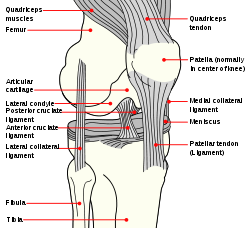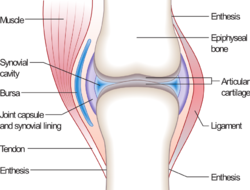- Ligament
-
Ligament 
Diagram of the right knee. 
Typical joint In anatomy, the term ligament is used to denote any of three types of structures.[1] Most commonly, it refers to fibrous tissue that connects bones to other bones and is also known as articular ligament, articular larua,[2] fibrous ligament, or true ligament.
Ligament can also refer to:
- Peritoneal ligament: a fold of peritoneum or other membranes.
- Fetal remnant ligament: the remnants of a tubular structure from the fetal period of life.
The study of ligaments is known as desmology (from Greek δεσμός, desmos, "string"; and -λογία, -logia).
Contents
Articular ligaments
"Ligament" most commonly refers to a band of tough, fibrous dense regular connective tissue comprising attenuated collagenous fibers. Ligaments connect bones to other bones to form a joint. They do not connect muscles to bones; that is the job of tendons. Some ligaments limit the mobility of articulations, or prevent certain movements altogether.
Capsular ligaments are part of the articular capsule that surrounds synovial joints. They act as mechanical reinforcements. Extra-capsular ligaments join together and provide joint stability. Intra-capsular ligaments, which are much less common,[citation needed] also provide stability but permit a far larger range of motion. Cruciate ligaments occur in pairs.
Ligaments are viscoelastic. They gradually lengthen when under tension, and return to their original shape when the tension is removed. However, they cannot retain their original shape when stretched past a certain point or for a prolonged period of time. This is one reason why dislocated joints must be set as quickly as possible: if the ligaments lengthen too much, then the joint will be weakened, becoming prone to future dislocations.[citation needed] Athletes, gymnasts, dancers, and martial artists perform stretching exercises to lengthen their ligaments, making their joints more supple.
The term "double-jointed" refers to people with more-elastic ligaments, allowing their joints to stretch and contort further. The medical term for describing such double-jointed persons is hyperlaxity.
The consequence of a broken ligament can be instability of the joint. Not all broken ligaments need surgery, but, if surgery is needed to stabilise the joint, the broken ligament can be repaired. Scar tissue may prevent this. If it is not possible to fix the broken ligament, other procedures such as the Brunelli procedure can correct the instability. Instability of a joint can over time lead to wear of the cartilage and eventually to osteoarthritis.
Examples
- Head and neck
- Cricothyroid ligament
- Periodontal ligament
- Suspensory ligament of the lens
- Thorax
- Suspensory ligament of the breast
- Pelvis
- Wrist
- Palmar radiocarpal ligament
- Dorsal radiocarpal ligament
- Ulnar collateral ligament
- Radial collateral ligament
- Knee
- Anterior cruciate ligament (ACL)
- Lateral collateral ligament (LCL)
- Posterior cruciate ligament (PCL)
- Medial collateral ligament (MCL)
- Cranial cruciate ligament (CrCL) - quadruped equivalent of ACL
- Caudal cruciate ligament (CaCL) - quadruped equivalent of PCL
- Patellar ligament
Peritoneal ligaments
Certain folds of peritoneum are referred to as ligaments. Examples include:
- The hepatoduodenal ligament, that surrounds the hepatic portal vein and other vessels as they travel from the duodenum to the liver.
- The broad ligament of the uterus, also a fold of peritoneum.
Fetal remnant ligaments
Certain tubular structures from the fetal period are referred to as ligaments after they close up and turn into cord-like structures:[citation needed]
Fetal Adult ductus arteriosus ligamentum arteriosum extra-hepatic portion of the fetal left umbilical vein ligamentum teres hepatis (the "round ligament of the liver"). intra-hepatic portion of the fetal left umbilical vein (the ductus venosus) ligamentum venosum distal portions of the fetal left and right umbilical arteries medial umbilical ligaments See also
References
Joints (TA A03.0, TH H3.02, GA 3.284) Types fibrous: Gomphosis · Suture · Syndesmosis · Interosseous membrane
cartilaginous: Synchondrosis · Symphysis
synovial: Plane joint · 1° (Hinge joint, Pivot joint) · 2° (Condyloid joint, Saddle joint) · 3° (Ball and socket joint)
by range of motion: Synarthrosis · Amphiarthrosis · DiarthrosisTerminology Motions general: Flexion/Extension · Adduction/Abduction · Internal rotation/External rotation · Elevation/Depression
specialized/upper limbs: Protraction/Retraction · Supination/Pronation
specialized/lower limbs: Plantarflexion/Dorsiflexion · Eversion/InversionComponents capsular: Articular capsule (Synovial membrane, Fibrous membrane) · Synovial fluid · Synovial bursa · Articular disk/Meniscus
extracapsular: Ligament · EnthesisM: JNT
anat(h/c, u, t, l)/phys
noco(arth/defr/back/soft)/cong, sysi/epon, injr
proc, drug(M01C, M4)
Joints and ligaments of head and neck (TA A03.1.03–08, GA 3.287) Temporomandibular capsule · articular disk
lateral (temporomandibular ligament) · medial (sphenomandibular ligament, stylomandibular ligament)Atlanto-occipital M: JNT
anat(h/c, u, t, l)/phys
noco(arth/defr/back/soft)/cong, sysi/epon, injr
proc, drug(M01C, M4)
Joints and ligaments of upper limbs (TA A03.5, GA 3.313) Shoulder Elbow Radial collateralUlnar collateralForearm Joints of hand Dorsal radiocarpal/Palmar radiocarpal · Dorsal ulnocarpal/Palmar ulnocarpal · Ulnar collateral/Radial collateralRadiate carpal · Dorsal intercarpal · Palmar intercarpal · Interosseous intercarpal · Scapholunate · Pisiform joint (Pisohamate, Pisometacarpal)OtherM: JNT
anat(h/c, u, t, l)/phys
noco(arth/defr/back/soft)/cong, sysi/epon, injr
proc, drug(M01C, M4)
Joints and ligaments of torso (TA A03.02–04, GA 3.299) Vertebral Of vertebral bodiesmedian: Cruciate ligament of atlas (Transverse ligament of atlas) · Alar ligament · Apical ligament of dens · Tectorial membrane of atlanto-axial joint
lateral: no ligaments
anterior atlantoaxial ligament · posterior atlantoaxial ligamentno ligamentsLumbosacralThorax Radiate ligament · Intra-articular ligamentno ligamentsno ligamentsPelvis anterior sacroiliac ligament · posterior sacroiliac ligament · interosseous sacroiliac ligament
ligaments connecting the sacrum and ischium: sacrotuberous ligament · sacrospinous ligament
Greater sciatic foramen · Lesser sciatic foramenM: JNT
anat(h/c, u, t, l)/phys
noco(arth/defr/back/soft)/cong, sysi/epon, injr
proc, drug(M01C, M4)
Joints and ligaments of lower limbs (TA A03.6, GA 3.333) Coxal/hip femoral (iliofemoral, pubofemoral, ischiofemoral) · head of femur · transverse acetabular · acetabular labrum · capsule · zona orbicularisKnee-joint TibiofemoralCapsule · Anterior meniscofemoral ligament · Posterior meniscofemoral ligament
extracapsular: popliteal (oblique, arcuate) · collateral (medial/tibial, fibular/lateral)
intracapsular: cruciate (anterior, posterior) · menisci (medial, lateral) · transversePatellofemoralTibiofibular Superior tibiofibularInferior tibiofibularJoints of foot medial: medial of talocrural joint/deltoid (anterior tibiotalar, posterior tibiotalar, tibiocalcaneal, tibionavicular)
lateral: lateral collateral of ankle joint (anterior talofibular, posterior talofibular, calcaneofibular)Distal intertarsalOtherM: JNT
anat(h/c, u, t, l)/phys
noco(arth/defr/back/soft)/cong, sysi/epon, injr
proc, drug(M01C, M4)
Fetal vascular remnant ligaments (GA 6) Heart Liver Umbilical Histology: connective tissue (TH H2.00.03) Composition ResidentCollagen fibers
Reticular fibers: COL3A1
Elastic fibers: Elastin · Fibrillin (FBN1, FBN2, FBN3) · EMILIN1
ElauninClassification LooseRelated see also Template:Soft tissue tumors and sarcomasCategories:- Soft tissue
- Skeletal system
- Ligaments
Wikimedia Foundation. 2010.
